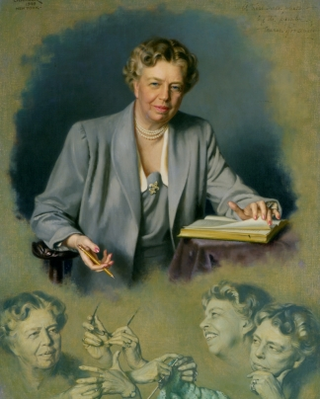
Lorena Alice "Hick" Hickok was an American journalist and long-term friend and possibly romantic partner of First Lady Eleanor Roosevelt.

Lucy Mercer Rutherfurd was an American woman who sustained a long affair with US president Franklin D. Roosevelt.

John Aspinwall Roosevelt II was an American businessman and the sixth and last child of U.S. President Franklin D. Roosevelt, and his wife, Eleanor Roosevelt.

Sara Ann Roosevelt was the second wife of James Roosevelt I, the mother of Franklin Delano Roosevelt, the 32nd President of the United States and her only child, and subsequently the mother-in-law of Eleanor Roosevelt.

Isabella Dinsmore Greenway was an American politician who was the first congresswoman in Arizona history, and the founder of the Arizona Inn of Tucson. During her life she was also noted as a one-time owner and operator of Los Angeles-based Gilpin Airlines, a speaker at the 1932 Democratic National Convention, and a bridesmaid at the wedding of Eleanor and Franklin D. Roosevelt.

Trude Lash, formerly Gertrude Pratt, née Wenzel was a political activist, advocate for children, and close associate of Eleanor Roosevelt.

Gracie Hall Roosevelt was an American engineer, banker, soldier, and municipal official who was the youngest brother of First Lady of the United States Eleanor Roosevelt and a nephew of President Theodore Roosevelt.

Anna Eleanor Roosevelt was an American political figure, diplomat, and activist. She was the first lady of the United States from 1933 to 1945, during her husband Franklin D. Roosevelt's four terms as president, making her the longest-serving first lady of the United States. Through her travels, public engagement, and advocacy, she largely redefined the role of first lady. Roosevelt then served as a United States Delegate to the United Nations General Assembly from 1945 to 1952, and took a leading role in designing the text and gaining international support for the Universal Declaration of Human Rights. In 1948, she was given a standing ovation by the assembly upon their adoption of the declaration. President Harry S. Truman later called her the "First Lady of the World" in tribute to her human rights achievements.

My Day was a newspaper column written by First Lady of the United States Eleanor Roosevelt (ER) six days a week from December 31, 1935, to September 26, 1962. In her column, Roosevelt discussed issues including civil rights, women's rights, and various current events. This column allowed ER to spread her ideas, thoughts, and perspectives on contemporary events to the American public through local newspapers. Through My Day, Roosevelt became the first First Lady to write a daily newspaper column. Roosevelt also wrote for Ladies Home Journal, McCall's, and published various articles in Vogue and other women's magazines.

Joseph Paul Lash was an American radical political activist, journalist, and writer. A close friend of Eleanor Roosevelt, Lash won both the Pulitzer Prize for Biography and the National Book Award in Biography for Eleanor and Franklin (1971), the first of two volumes he wrote about the former First Lady.
Earl Miller was a New York State Trooper who was a bodyguard and close friend of future First Lady of the United States Eleanor Roosevelt during her term as First Lady of New York. Whether the pair's relationship included a romantic element has been a subject of debate among historians.

Elinor Lehman Morgenthau was an American Democratic party activist, member of the Lehman family, and spouse of Henry Morgenthau Jr.
Arno David Gurewitsch (1902–1974) was a medical doctor and medical expert whose career spread across Germany, Israel, and the United States.

Anna Eleanor Roosevelt was the First Lady of the United States, from March 4, 1933 to April 12, 1945; as the wife of President Franklin D. Roosevelt. Because her husband was the longest-serving president, Eleanor is the longest-serving First Lady.

This is My Story is a 1937 autobiographical memoir by Eleanor Roosevelt, an American political figure, diplomat, activist and First Lady of the United States while her husband, Franklin D. Roosevelt, was President of the United States. This is My Story was the first of four memoirs written by Roosevelt, the other three being This I Remember, On My Own, and The Autobiography of Eleanor Roosevelt. It was very well received by critics and a financial success.

This I Remember is a 1949 memoir by Eleanor Roosevelt, an American political figure, diplomat, activist and First Lady of the United States while her husband, Franklin D. Roosevelt, was President of the United States. This I Remember was one of four memoirs written by Roosevelt, the other three being: This Is My Story, On My Own, and The Autobiography of Eleanor Roosevelt. It was received well by critics and was a commercial success.

The Autobiography of Eleanor Roosevelt is a 1961 memoir by Eleanor Roosevelt, an American political figure, diplomat, activist and First Lady of the United States while her husband, Franklin D. Roosevelt, was President of the United States. The Autobiography was the fourth of four memoirs written by Roosevelt, the other three being: This Is My Story (1937), This I Remember (1949), and On My Own (1958). She combined those three into The Autobiography. The book was generally well received by critics, who particularly appreciated how the combined memoirs showed Eleanor's development.

Eleanor: The Years Alone is a 1972 biography of Eleanor Roosevelt written by Joseph P. Lash. It is a companion volume to Eleanor and Franklin (1971), which covers her life through the death of her husband, United States President Franklin D. Roosevelt. Eleanor: The Years Alone describes her life thereafter.
Bess Furman Armstrong was an American journalist. She covered the White House during five presidential administrations, as a reporter for the Associated Press from 1929 to 1936, then as a correspondent for The New York Times from 1943 to 1961. Her close relationship with Eleanor Roosevelt shaped her career as she reported on Roosevelt's political activities, unprecedented for a First Lady. During the 1960s, Furman was the top public affairs official in the Department of Health, Education and Welfare.
















